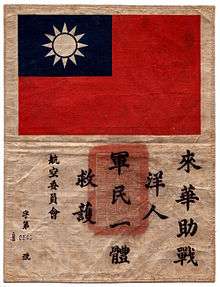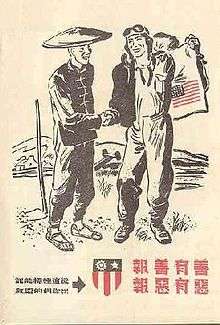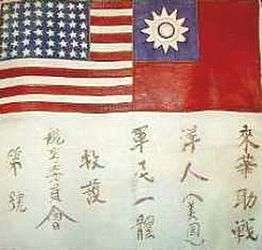Blood chit
A blood chit is a notice carried by military personnel and addressed to any civilians who may come across an armed-services member – such as a shot-down pilot – in difficulties. As well as identifying the force to which the bearer belongs as friendly, the notice displays a message requesting that the service member be rendered every assistance.



I am an American (UNITED NATIONS) pilot. My plane has been shot down and I am helpless, but I want to get back and fight again for the peace of the world and your country.
If you will help me and yourselves by getting me to the nearest American unit, my Government will reward you. Help me and we will help you.
| Blood chit | |||||||
|---|---|---|---|---|---|---|---|
| Chinese name | |||||||
| Chinese | 血幅 | ||||||
| Literal meaning | blood chit | ||||||
| |||||||
| Japanese name | |||||||
| Kanji | 人物証明書 | ||||||
| |||||||
Etymology
Alternative names are escape and identification flags (Chinese: 人物證明書; pinyin: rénwù zhèngmíng shū). Chit (also 'chitty') is a British English term for a small document, note or pass, representing a debt to be paid; it is an Anglo-Indian word dating from the late 18th century, derived from the Hindi citthi.[1]
History
The first blood chit may have been made in 1793 when French balloonist Jean-Pierre Blanchard demonstrated his hot air balloon in the United States. Because he could not control the direction of the balloon, no one knew where he would land. Because Blanchard did not speak English, George Washington, according to legend, gave him a letter that said that all U.S. citizens were obliged to assist him to return to Philadelphia.[2]
In World War I, British Royal Flying Corps pilots in India and Mesopotamia carried a "goolie chit" printed in four local languages that promised a reward to anyone who would bring an unharmed British aviator back to British lines. The British officer John Masters recorded in his autobiography that Pathan women in the North-West Frontier Province (1901–1955) of British India (now modern day Pakistan) during the Anglo-Afghan Wars would behead and castrate non Muslim soldiers who were captured, like British and Sikhs.[3]
In the Second Sino-Japanese War prior to World War II, foreign volunteer pilots of Flying Tigers carried notices printed in Chinese that informed the locals that this foreign pilot was fighting for China and they were obliged to help them.[4] A text from one such blood chit translates as follows:
I am an American airman. My plane is destroyed. I cannot speak your language. I am an enemy of the Japanese. Please give me food and take me to the nearest Allied military post.
You will be rewarded.
On the UN chit from the Korean war, it is written in Japanese that cooperators will be rewarded and should help for his own 'benefit'.
United States Armed Forces
When the U.S. officially entered World War II in December 1941, flight crew survival kits included blood chits printed in 50 different languages that sported an American flag and promised a reward for a safe return of a pilot. The kit might also include gifts like gold coins, maps or sewing needles. Many U.S. flight crews that flew over Asia had their "blood chit" sewn to the back of their flight jackets. Some units added the blood chit to the crew's flight suits while other units gave the blood chit out only for specific flights. Currently, blood chits are a product of the Joint Personnel Recovery Agency. They are a small sheet of Tyvek material with an American flag and a statement in several languages indicating that the U.S. will reward anyone assisting the bearer to safety. They represent a written promise or obligation of the US Government.
While serving in the Global War on Terrorism, many U.S. service members were issued "blood chips" that looked similar to bearer bonds and guaranteed $500,000 for "aid and safe return". They were issued before missions for select ground, and convoy personnel, and placed inside a soldiers ballistic vest prior to missions.
British Armed Forces

Examples of blood chits issued to British RAF personnel in India in the 1940s are printed on thin sheets of silk cloth measuring 20 by 11½ inches (about 50 x 30 cm); they have the Union flag printed at the top left, and the following text in English and French alongside it:
Dear Friend,
I am an Allied fighter. I did not come here to do any harm to you who are my friends. I only want to do harm to the Japanese and chase them away from this country as quickly as possible.
If you will assist me, my Government will sufficiently reward you when the Japanese are driven away.
The main area of the document is printed in three columns with the same text in 15 Asian languages, including Malay, Burmese, Tamil, Thai and Bengali.
Notes
- "Chit source". Retrieved 22 February 2012.
- "The Flying Tigers, America's secret army in Burma". Smithsonian Asia Pacific America Center. Retrieved June 6, 2019.
- John Masters (June 13, 2002). Bugles and a Tiger. Cassell Military (June 13, 2002). p. 190. ISBN 0-304-36156-9. Retrieved 5 April 2011.
- Rossi, Dick (1980s). "A Flying Tigers Story". The Flying Tigers - American Volunteer Group - Chinese Air Force.
- Satte løsepenger på norske spesialsoldater
References
- Rossi, J.R. "AVG American Volunteer Group - Flying Tigers".
External links
| Wikimedia Commons has media related to Blood chit. |
- The Flying Tigers blood chit
- Blood Chits of the CBI Theater
- Personnel Recovery in the Department of Defense
- Photo of US Afghanistan Blood Chit
- Chivers, C.J. (29 March 2012). "A Short History of Blood Chits: Greetings From the Lost, Seeking Help". The New York Times. Retrieved 12 September 2016.